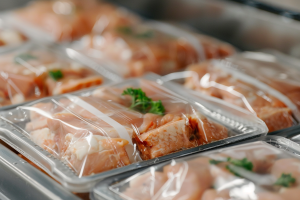Too Cool For Freezing – Understanding Food Safety Temp Zones

Welcome, foodies and fridge enthusiasts! Today, we’re diving deep into the world of temperatures—where science meets deliciousness. Buckle up (or should we say “buckle cool”?), because we’re about to uncover the icy secrets of food safety and storage!
Temperature Tango: Finding Your Food’s Happy Place
Ever wondered why your strawberries get mushy or your milk turns funky faster than you can say “fridge”? It’s all about hitting that sweet spot on the thermostat. Different foods have different needs, and knowing those needs is like having the secret recipe to freshness!
Let’s break it down, shall we? Too warm, and your dinner leftovers could become a breeding ground for those pesky bacteria. Too cold, and your lettuce might freeze into a sad, wilted iceberg. It’s a temperature tango, and we’re here to teach you the steps! And, the freezer—a magical land where ice cream dreams come true, but not always for everything else. Did you know some foods lose their flavour or texture in the frosty depths? It’s like sending your favourite dish on an icy adventure, only to have it come back a little worse for wear.
Molecular Mischief: Why Temperature Matters in food safety
Let’s get scientific (but keep it snappy)! At warmer temps, those food molecules party like it’s Friday night, inviting bacteria along for the ride. Cooler temps? Think of it as hitting the pause button on the bacteria disco. That’s the magic of food safety in action!
Certified Cool: The Importance of Food Safety Certificates
When in doubt, look for the stamp of approval! A food safety certificate isn’t just a piece of paper—it’s your ticket to peace of mind. Let’s take a frosty plunge into the world of commercial cold chain storage—where keeping things chilled isn’t just a preference, it’s a way of life for industries like food production, pharmaceuticals, and even those dealing with chemical conundrums. Buckle up your ice skates (or should we say, “buckle up your snow boots”?), because we’re about to slide into the chilly details of how we keep our goodies fresh and fabulous!
Commercial Cold Chain: Preserving Quality and Safety
Picture this: a dance floor where freshness meets safety in perfect harmony. That’s what the commercial cold chain is all about! From the moment goods are born to when they hit your plate (or your pharmacy shelf), it’s a carefully orchestrated symphony of temperature-controlled bliss. We’re talking about keeping strawberries sweet, milk creamy, and medicines potent—all thanks to the magic of temperature control.
Here’s a fun and informative guide to food safe temperature zones in Celsius:
Welcome to the cool side of food safety—where temperatures rule and freshness reigns supreme! Let’s break down the Celsius zones that keep our food safe and delicious, from frozen treats to hot meals. Get ready to chill out and learn!
- Frozen Food Zone (Below -18°C)
First stop: the frozen food zone, where ice cream dreams come true! This Arctic paradise keeps everything rock-solid, perfect for long-term storage of frozen goodies like ice cream, meats, and ready-to-cook meals. Just remember, too long in here and even the toughest steak can get freezer burn!
- Cold Food Zone (0°C to 4°C)
Next up, the cold food zone—your fridge’s favourite hangout. This zone is all about chilling out without freezing. It’s ideal for perishables like dairy, fruits, veggies, and cooked leftovers. Keep your milk cold, your salads crisp, and your meats ready for the grill. Pro tip: set your fridge around 3°C for optimal freshness!
- Danger Zone (4°C to 60°C)
Hold up! Enter the danger zone, where things can heat up—literally. This temperature range is a no-go for food because it’s prime time for bacteria to party. From 4°C to 60°C, bacteria multiply faster than you can say “foodborne illness.” Avoid keeping food here for too long—especially cooked dishes and leftovers—unless you want an unplanned stomach rumble.
- Hot Food Zone (Above 60°C)
Last but not least, the hot food zone—where meals are served sizzling! This zone is for keeping your freshly cooked dishes piping hot before serving. Whether it’s a hearty stew or a cheesy lasagna, make sure your hot food stays above 60°C to keep it safe and scrumptious.
Remember, mastering these temperature zones isn’t just about food safety—it’s about enjoying fresh, tasty meals without the risk of unwanted guests (we’re looking at you, bacteria!). So, whether you’re freezing, chilling, avoiding danger, or keeping things hot, here’s to staying cool, safe, and deliciously informed!
Key Elements of Commercial Cold Chain Storage:
Temperature Control: It’s all about keeping it cool, folks! Whether it’s freezing temps for our frozen pals or just the right chill for delicate dairy and produce, we’ve got the thermostat dialled in to perfection.
Storage Facilities: Think of these as the luxury spas for our products. Specialised refrigerated warehouses and cold storage units ensure our goods stay as fresh as a daisy. Complete with temperature monitors and backup generators, because even products need a backup plan!
Transportation: Cue the refrigerated trucks, containers, and ships—our icy chariots of choice. They’re like mobile freezers on wheels, ensuring our goods travel in style, insulated and cooled to perfection. We’re talking about keeping the cold chain intact from farm to fork (or factory to pharmacy).
Handling Protocols: No touchy-touchy without proper procedure! Strict handling rules ensure our goodies stay within safe temperature limits at all times. It’s like a VIP escort for your produce, ensuring minimal exposure to pesky warm air.
Monitoring and Quality Assurance: We’ve got our eyes (and sensors) on the prize! With state-of-the-art tech like temperature sensors, data loggers, and real-time tracking systems, we keep a close watch on every chill-inducing detail. Because in the cold chain, visibility is key to keeping things frosty and fabulous.
Benefits of Commercial Cold Chain Storage:
Preservation of Freshness: From juicy fruits to creamy cheeses, our cold chain keeps everything tasting as fresh as if it were just plucked from the orchard or dairy farm.
Prevention of Spoilage: Ain’t nobody got time for icky bacteria! By keeping things cool and controlled, we minimise the growth of nasties that could turn your favourite snack into a science experiment.
Extended Shelf Life: Who says you can’t freeze time? Well, maybe not time, but definitely the shelf life of our products. Thanks to our chilly embrace, goods can hang out a bit longer without losing their magic.
Regulatory Compliance: We’re not just cool—we’re FDA and USDA approved cool! Meeting the highest standards in food safety regulations ensures that what you get is not only fresh but also safe to enjoy.
So there you have it, folks! The commercial cold chain isn’t just about keeping things cold—it’s about keeping them cool, fresh, and safe from farm (or factory) to table. Next time you bite into a crisp apple or pop a pill, remember the chilly journey it took to get there. Stay frosty, stay fabulous, and keep on chillin’!


